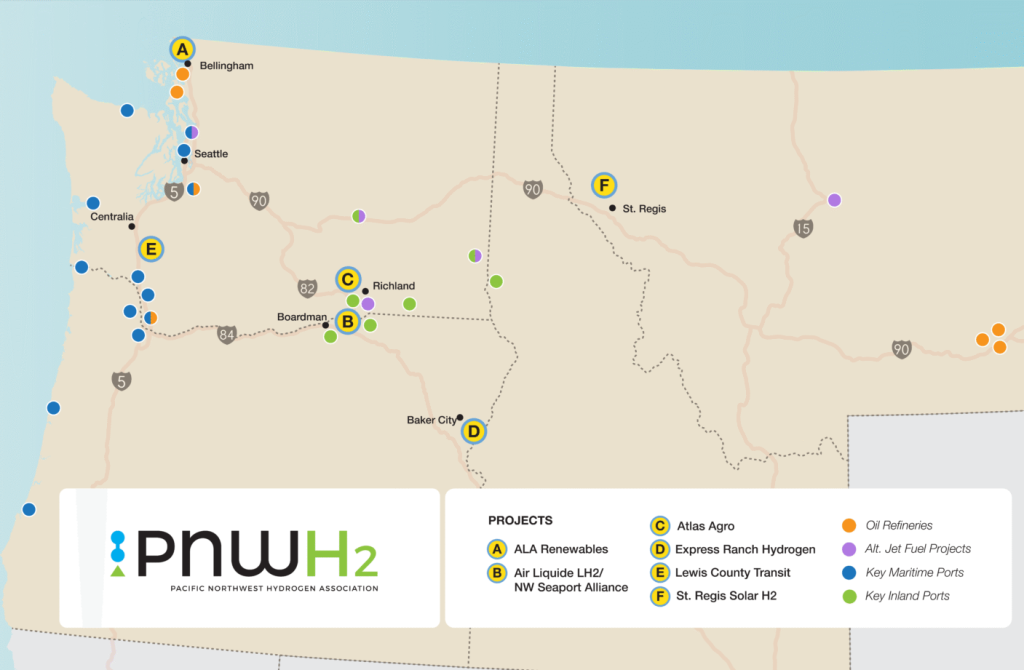Pacific Northwest Hydrogen Hub Faces Setback as Federal Funding Cut
In a significant blow to clean energy development in the Pacific Northwest, the Trump administration announced yesterday the cancellation of $1 billion in federal funding for the Pacific Northwest Hydrogen Association (PNWH2). This multi-state initiative, which encompassed Washington, Oregon, Idaho, and Montana, was one of seven regional hydrogen hubs selected two years ago as part of a nationwide effort to establish a hydrogen economy. The hub represented a promising opportunity for the region, leveraging its abundant clean energy resources, pioneering researchers, and over $5 billion in committed local investment to demonstrate the viability of clean hydrogen as an alternative fuel source. The project aimed to create more than 10,000 jobs, primarily in rural areas, while developing infrastructure to support hydrogen fuel production and use across various industries. Senator Maria Cantwell of Washington characterized the cancellation as “unprecedented and corrupt,” highlighting the rigorous national competition the region won to secure the funding initially.
The Department of Energy defended the funding cuts by claiming the affected projects “did not adequately advance the nation’s energy needs, were not economically viable, and would not provide a positive return on investment of taxpayer dollars.” However, the geographic pattern of the cancellations—affecting predominantly blue-leaning states including California, Oregon, Colorado, Hawaii, Illinois, New Mexico, New York, New Jersey, and several New England states—has raised concerns about political motivations. Russ Vought, director of the U.S. Office of Management and Budget, explicitly framed the decision in political terms, describing the canceled funding as “Green New Scam funding to fuel the Left’s climate agenda.” The DOE has given award recipients 30 days to appeal the cancellations, with some already beginning that process. Washington Governor Bob Ferguson has vowed to fight what he called an “illegal action,” working with the Attorney General’s Office to challenge the decision, emphasizing that “these projects will lower costs, create jobs, and reduce air pollution.”
The impact of these cuts extends far beyond the hydrogen hub itself. Washington state alone is losing funding for multiple clean energy initiatives, including $46.6 million for Nippon Dynawave in Cowlitz County, $68 million across two PACCAR projects in Skagit County, $10 million for CleanFiber in Lewis County, $5.3 million for Spokane Edo in Spokane County, $3 million for SilFab Solar WA in Skagit County, and $9.8 million across four Washington State University projects in Whitman County. The hydrogen hub was particularly promising because of clean hydrogen’s potential to decarbonize sectors that have proven difficult to electrify, such as steel and cement manufacturing, shipping, and heavy-duty trucking. The technology involves splitting water through electrolysis powered by renewable energy sources like solar, wind, or hydroelectric power to create “green” hydrogen—a significant improvement over traditional hydrogen production methods that rely on methane and produce substantial carbon emissions. When used as fuel, hydrogen creates water as its primary emission, making it an attractive alternative for reducing greenhouse gas emissions in hard-to-abate sectors.
Washington state has emerged as a leader in hydrogen technology development, with numerous companies actively advancing the field. PACCAR has been developing hydrogen fuel cell semi trucks to decarbonize freight transportation. Modern Hydrogen, backed by Bill Gates, is building innovative devices that produce hydrogen from methane gas. OCOchem is working on technology to convert captured carbon dioxide into industrial compounds that serve as feedstocks for hydrogen and other chemicals. In the aviation sector, ZeroAvia has established research, development, and manufacturing operations in Washington, including a partnership with Alaska Airlines to retrofit a retired plane with hydrogen-electric propulsion systems. Tech giants Amazon and Microsoft have formed partnerships with hydrogen fuel cell company Power Plug, while First Mode—despite filing for bankruptcy last year and being acquired by Cummins—continues its work on hydrogen hybrid powertrains. This ecosystem of innovation demonstrates the state’s commitment to developing hydrogen as a key component of its clean energy future.
The funding cuts come at a critical juncture for the hydrogen industry, which has been gaining momentum as governments and businesses worldwide recognize its potential to help meet climate goals. Clean hydrogen offers a unique solution for decarbonizing sectors where direct electrification is challenging or impractical. The DOE’s hydrogen hub program was designed to accelerate the development of regional hydrogen economies by supporting infrastructure, technology deployment, and market development. Each hub was intended to serve as a demonstration of how hydrogen could be produced, distributed, and used at scale, providing valuable real-world data and experience to inform broader adoption. The hubs were also meant to create jobs and economic opportunities, particularly in regions transitioning away from fossil fuel-dependent industries. By cutting funding for these initiatives, critics argue the administration is not only hampering climate action but also forfeiting economic benefits and competitive advantages in an emerging global industry.
Despite this significant setback, industry leaders remain determined to advance hydrogen technology and infrastructure in the Pacific Northwest. Chris Green, president of the Pacific Northwest Hydrogen Association, expressed optimism about the sector’s future, noting that “the progress we made over the past year—deepening partnerships, supporting investment, and promoting the innovation and infrastructure needed to keep hydrogen at the forefront of America’s energy future—has created lasting momentum.” This sentiment reflects the broader resilience of the clean energy transition, which continues to progress despite policy fluctuations. The private sector investments and partnerships established through the hub’s development process may continue independently, albeit at a slower pace without federal support. Additionally, state-level policies and incentives in Washington and Oregon continue to encourage clean energy development. While the loss of $1 billion in federal funding represents a significant challenge for the Pacific Northwest’s hydrogen ambitions, the foundation laid through collaborative planning, technical advancement, and stakeholder engagement provides a platform from which to continue building a hydrogen economy, even if the path forward now requires greater reliance on private capital and state-level support.


